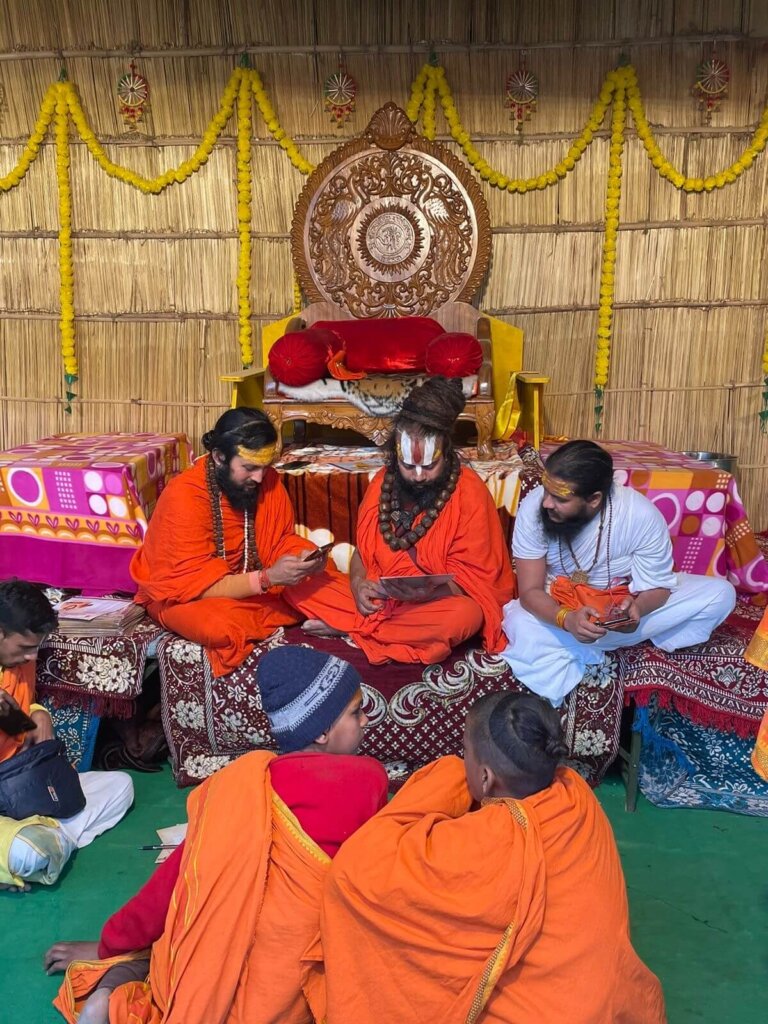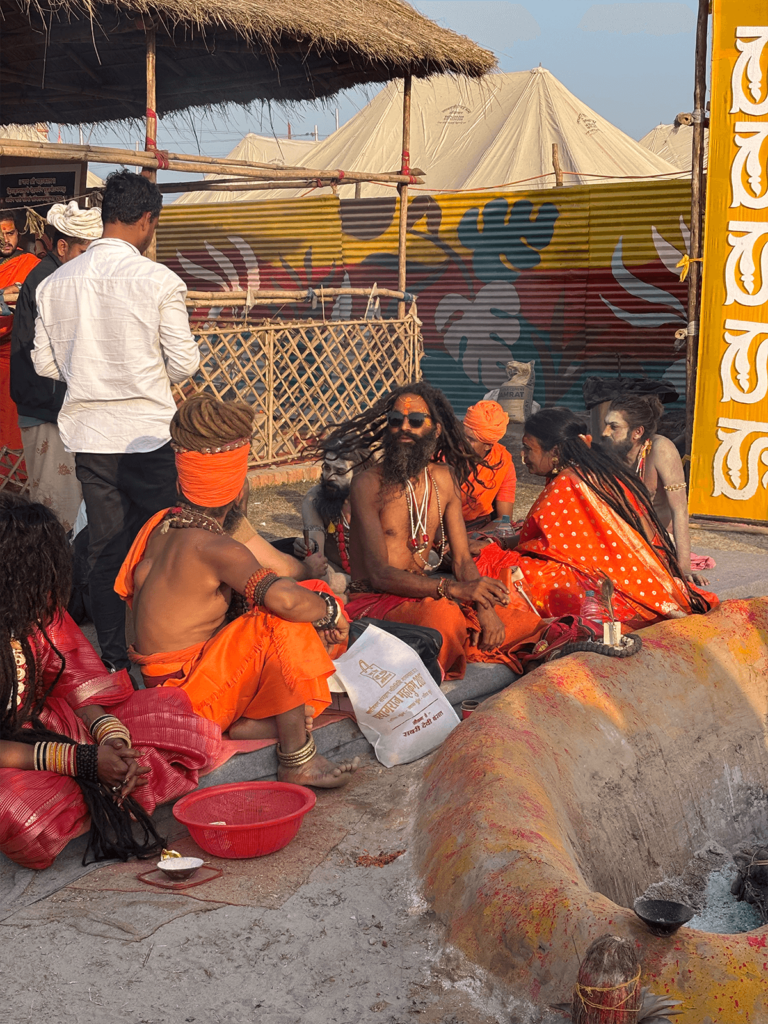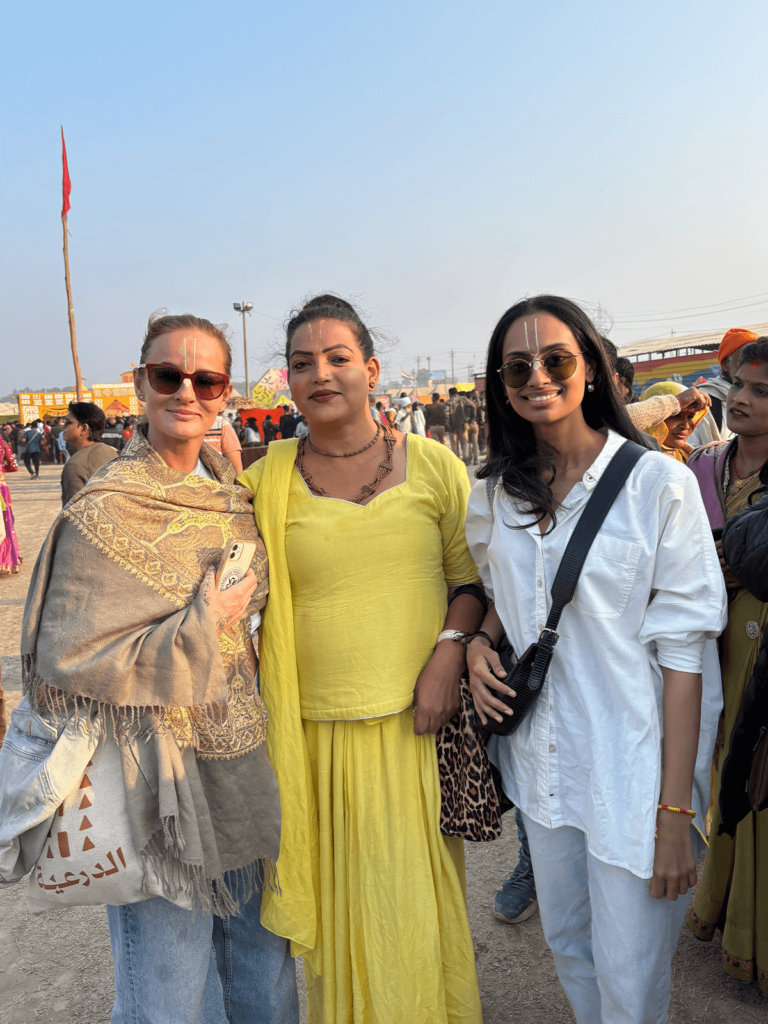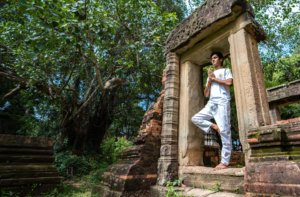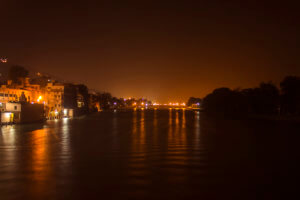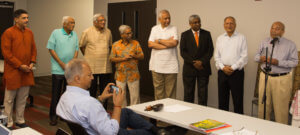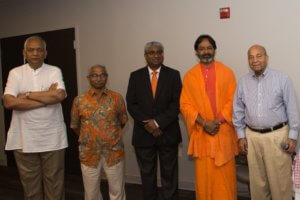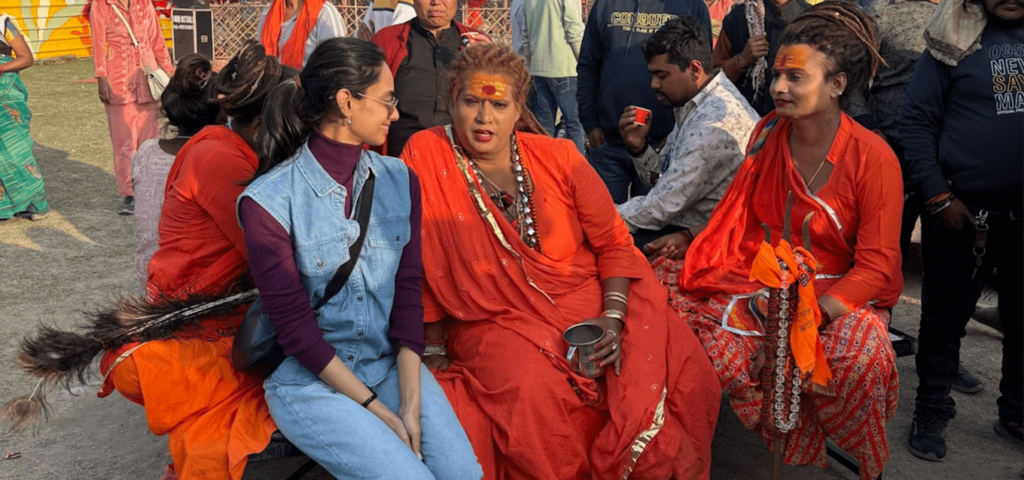
The Kumbh Mela is no ordinary festival.It is not just a gathering, nor just a spectacle. It is the living, breathing soul of Sanatana Dharma. The mela is an ancient tradition pulsating with the wisdom of rishis, the blessings of saints, and the devotion of divine seekers. Imagine a festival as grand as a large music festival but rooted in something far deeper, the very core of Hindu spirituality, where lineages of gurus, saints, and sadhus come together in an unparalleled expression of unity, authenticity, and devotion.
Even now, back home, something within me has shifted. The magic of that experience, the energy of those blessings, and the memories of those who have dedicated their entire lives to intense tapasya remain with me. Their unwavering love for Hinduism, its sacred practices, and, most importantly, their deep, personal connections to their deities has left me profoundly inspired. How did our ancestors conceive of something so magnificent? A vision, an idea, a concept that has withstood the test of time, through invasions, colonization, and relentless attempts to alter our faith, our identity, and our very existence. And yet, the Kumbh Mela continues, unwavering, standing as a testament to the resilience of Sanatana Dharma.
The Kumbh Mela takes place during a sacred planetary alignment that occurs once every twelve years and guides humanity towards moksha. But this time was different. Twelve cycles of twelve years had completed, making it a once in a lifetime moment. A gathering witnessed by my ancestors 144 years ago, and one that my descendants will see 144 years from now. The Mahakumbh Mela is a time when the enlightened seers, sages, ascetics emerge from their solitude and tapasya to share their wisdom and powers with the world. It is a space where everyday people, engrossed in the material world, can freely seek knowledge, blessings, and deeper understanding. It is a divine confluence of sacred rivers where amrit, the nectar of immortality, once fell; of faith and devotion. It is where tradition lives on, since Adi Shankara established it in the 8th century.
This year, the event was publicized in a way that drew urban Hindus and seekers from across the globe to participate in this extraordinary celebration of faith. To witness the seamless coexistence of centuries old traditions with a new, modern wave of devotees was humbling. Seekers regardless of background had come together in pursuit of knowledge, faith and moksha.
I felt grateful for those rural and working class Hindus who, despite abject poverty and unimaginable hardships, have kept this sacred tradition alive. Every kumbh mela, they come, walking miles under the scorching sun, carrying small children, guiding their aging parents, and sleeping under the vast, chilly night sky of the Mela grounds. Their unwavering faith and devotion ensured that this timeless event never faded. A newfound pride and understanding are bringing more Indians back to their roots, reconnecting them to the richness of their own traditions, to reclaim what is theirs and for that, we must thank those who never left, who never forgot, and who carried the Kumbh Mela forward for all of us.
If there is such a thing as a calling, being drawn to holy places only when the deities and saints summon you, then this was it. There’s no other way to explain how I found myself in Kashi and Prayagraj, experiencing the magic of this extraordinary Kumbh Mela. I hadn’t planned for it, yet there I was, on a flight to Kashi, then making my way to the Mela.
On our first day at the Kumbh Mela, we arrived at the newly built city around 11 AM and had our cab drop us off at the designated parking area. Excited and eager to explore, we began asking the police, who were everywhere, patiently guiding and helping pilgrims, where we could go to meet the sadhus and sanyasis. They informed us that the main ‘akhadas’ were about 15 km away and that we would have to walk there.
A bit anxious but determined, we started our journey under the scorching winter sun. Just 10 minutes in, we came across the kindest auto driver, Birendra Yadav, who insisted we call him Pappu. And Pappu was nothing short of a godsend! In the vastness of the Kumbh, where we were a group of seven, we would have needed a large auto to fit us all and as if it were meant to be, that’s exactly what Pappu drove. We squeezed into his six seater auto and asked him to take us towards the akhadas. I wasn’t entirely sure what that meant or what to expect, but I had read that this was the heart of the Mela, where we would get to meet the saints and sadhus.
As Pappu kept driving, we realized just how far the area actually was, and how much walking we would have had to do without him and his auto. We were beyond grateful and also starving, since it took us nearly 25 minutes just to reach the main area. We went directly to the ISKCON camp which had a massive kitchen and a 24/7 prasadam hall for lunch. The camp was beautiful, with artistic recreations of scenes from the Mahabharata and Ramayana, featuring Krishna, Hanuman, Sita and Lakshmana. We enjoyed the most delicious full Indian meal alongside hundreds of other devotees and visitors, all relishing the free prasadam offered to every guest. It was the perfect way to fill our stomachs before continuing toward the rest of the akhadas.
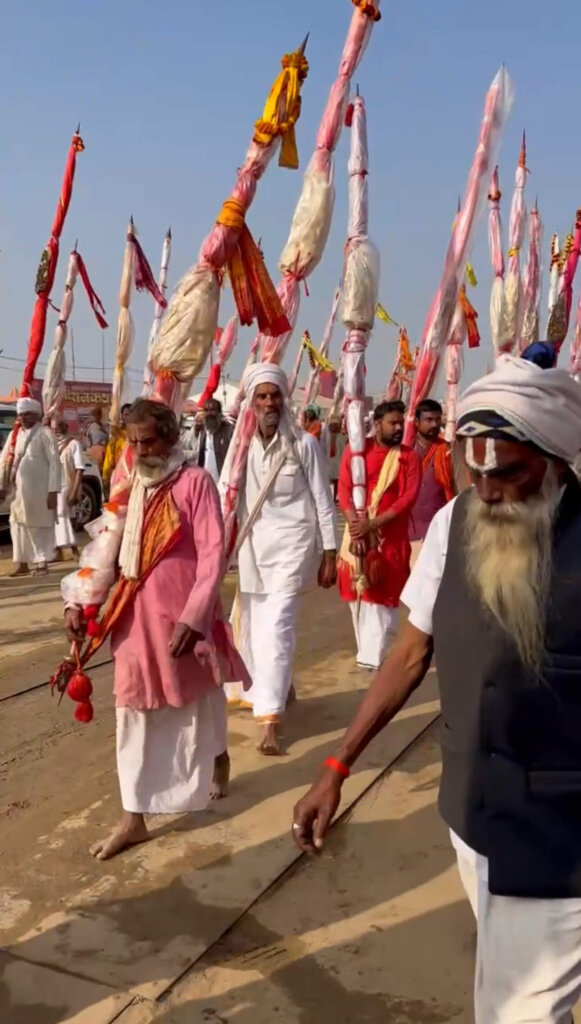
ISKCON also had a bookstall where visitors could pick up as many books on Hinduism as they liked, free of cost. Their devotees warmly placed the special Vishnu tilak made of pure chandan on our foreheads. It was beautiful. One of my favorite parts of the mela was receiving tilaks and raksha or ‘protective’ tikkas from the various sadhus and babas as they gave their blessings. I hadn’t realized how beautiful I found them on my face until I removed them at the end of the day.
On our way to the Kinnar Akhada, which Pappu suggested we visit first, we encountered the most vibrant procession of all the Vaishnava sampradayas at the Kumbha mela. The energy was high. As we tried to move forward, the police stopped us, explaining that no vehicles were allowed to cross as the procession was about to pass. The Vaishnava sadhus had to move as one, undisturbed. So we waited eagerly on the side watching as the sadhus, saints and acharyas from different sampradayas proudly showcased their heritage. Some rode atop decorated trucks, horses or even elephants, while others walked in perfectly organized droves. Some waved their sacred weapons high in the air, while others simply smiled and waved at us with pure joy. The entire scene was alive with children dressed as Rama, Sita and Hanuman, the beating of drums, the sound of trumpets, and an array of colorful attire. But what stood out the most was the sacred Vaishnava tilak bold in white and red, adorning every forehead, a mark of their devotion to Vishnu and his avatars. It was a moment of pure celebration, and we were lucky to witness it.
What made the moment even more special was the heartfelt exchange of respect along the procession route. The head saint from every camp along the route of the procession, and their followers, stood outside, garlands in hand, ready to honor the revered saints of the Vaishnava sampradayas as they passed. Each time they stopped to greet one another, they smiled delightedly and exchanged words of praise, recognizing each other’s greatness. It was one of the most endearing sights to witness, a beautiful display of unity among the Hindu sects, filled with genuine admiration, mutual respect and a shared devotion that transcended differences.
The Kinnar Akhada took our breath away. As I mentioned, we had no idea what to expect, but the moment we entered, we were enveloped in a world unlike any other. Groups of kinnars sat gracefully on traditionally woven cots, each with their own small setup. Dressed in flowing robes of orange, yellow and red, their kohled eyes and bold lips, big round bindis, and luxurious hair made them look radiant, almost ethereal. Their presence was commanding yet magnetic. As we stepped closer, one of the kinnars looked at me warmly and invited me to sit beside them. Among a group of Europeans, they seemed especially happy to see an Indian and asked me where I was from. When it was time to leave, I instinctively bent to touch their feet. At that moment, one of them gently placed her hands, first, on my back and shoulders, then on my head. I had never felt anything like it before, an energy so heavy, yet so calming, deeply maternal and overwhelmingly loving. It was a moment of pure grace, powerful yet calming, as if I had been blessed by something beyond words.
In the same akhada or camp, was also the aghori space where the aghori priests carried out one of the most elaborate pujas for Ma Kali I had ever seen. Rhythmic beats of a large damaru filled the air as the priests performed arti, other sacred rites and kept gently touching the face of the Goddess just as one would caress a mother’s face or someone with whom they shared a deep, personal bond. The atmosphere was intense and filled with positive energy as they prayed to Ma Kali and sanctified the akhada with the rituals. The experience left us in awe.
Next we made our way towards Sectors 20 and 21, the Panchadashanam Juna Akhada, commonly known as Juna akahada and the Niranjanai akhada. These are the main camps of the Naga Sadhus, the most mystical figures of the Kumbh Mela. I was excited to witness the tradition first hand, having seen images and videos of the magnificent processions of the naga sadhus descending towards the river for the auspicious ritual of the shahi snan. The ascetic warriors of the Dashanami Akhada tradition, founded by Adi Shankaracharya centuries ago, had played a crucial role in defending Hindu religious practices and temples from invaders. In 1664, they bravely fought and defeated Aurangzeb’s army to protect the sacred Kashi Vishwanath Mandir in Varanasi.
Just before entering the Akhada, we came across some Naga Babas lounging in tents outside. One of them, ash smeared and holding vibhuti in his hand, leaned casually against a motorbike. He smiled warmly and gestured for us to come closer for a blessing. Sensing my slight hesitation, though not out of disrespect, but because this was my first interaction with a Naga Sadhu, he smiled even wider. Extending his hand in a gesture of reassurance, he softly encouraged us and so I stepped forward. As soon as I was close enough, he placed his hand gently over my head, applying vibhuti to my forehead for protection. With deep kindness, he blessed me, saying, ‘Bhagwan sada tumhe sadbuddhi de’-May God always grant you wisdom, and my heart just melted.
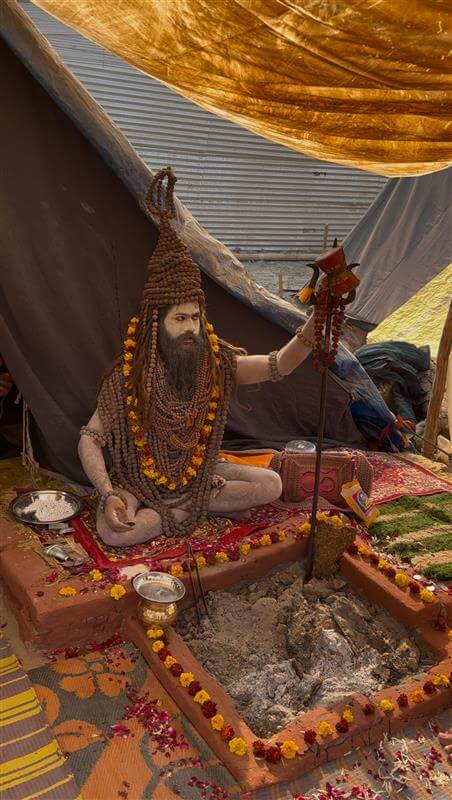
Although we began to see naga sadhus either sitting by the side of the road or in the tents lining the roads as soon as we entered the main akhada area, it was at the Juna and Niranjani akhadas that we properly engaged with them.
The Naga Sadhus are often regarded with a mix of reverence and fear. But to me, that fear seemed entirely misplaced. Once you look beyond their ash smeared bodies and long dreadlocks, you see something else: the kindest, most compassionate eyes. Every Baba I met had a deeply positive and loving energy, and was eager to place a protective hand on our heads to bless us with vibhuti, and share his wisdom. There was nothing to fear; only something profound to experience.
Another incident comes to mind: when one of the Naga Babas blessed me by firmly patting my back six times, it felt intense and deeply powerful. Then, he handed me a Rudraksha and instructed me to tie it to a red thread and wear it around my neck. Curious, I asked him how it would help me and without a moment’s hesitation, he replied- ‘it will support you in your Adhyatmik (philosophical) studies in Hinduism, of course!’ I was stunned. How did he know I was a student of Hinduism? Perhaps I was reading too much into it, but the moment felt profound. His blessing felt pure and deeply real.
What fascinated me most was how, despite being complete renunciates, detached from all material possessions, they carried an ethereal beauty. Wrapped in flower garlands, their matted locks adorned with blooms and their bodies draped in long strands of Rudraksha, they looked just like Shiva himself. It was as if Shiva’s very essence lived within them. Just like Shiva, who appears fierce yet is the kindest, most innocent and loving, these sadhus embodied that same paradox. The truth is, the naga sadhus are gentle and pure. One experience of their blessings and something shifts within you. I only felt gratitude for these divine beings, reservoirs of spiritual power, who were sitting there, selflessly and kindly offering the fruits of their tapasya and accumulated energy as blessings so that others such as me could benefit.
At sunset, we went to the ghat for a dip and offered prayers to Ganga. The evening light was beautiful and, as the temperature dropped, the cool water felt refreshing and pure. On our way back to the auto, we noticed the akhadas coming to life with preparations for seva. Stalls had been set up, offering fresh, steaming khichdi and other dinnertime prasad, completely free for all devotees so that no one at the Kumbh Mela would go hungry. We enjoyed some delicious khichdi, even going back for second servings at one of the stalls. Just as we finished, we realized it was time for the evening aarti as the sound of bells ringing across all the akhadas filled the air.
We returned to the shivir of the Shankaracharya of Jyotirmath, where, earlier in the day, we had witnessed a grand yajna with 1,100 priests performing sacred rituals for the protection of the holy cow, advocating for its recognition as Rashtra Mata (the national mother). Now, the evening aarti was in full swing, over a hundred priests, along with hundred young balayogis, children and young yogis sat in perfect formation, ringing bells in the background as the rituals unfolded. A few moments later, we had the incredible opportunity to meet the Shankaracharya of Jyotirmath himself. The experience was beyond amazing, making me realize how fortunate we are for this one of a kind gathering. Instead of traveling across Bharata to various ashramas of all the different lineages, the dynamic mela gives us endless opportunities for spiritual growth and wisdom, to meet the saints, sadhus and gurus from all traditions, all in one place. A massive fair, a sacred convergence of these divine sadhus and gurus. You can walk up to them, ask them anything or simply receive their blessings. The energy at the mela was powerful and distinct, each baba and guru radiated something unique.
Everything was taking place seamlessly at the Mela staying true to age old Hindu traditions in the most authentic way including initiations, havans, daily pujas, yajnas and kathas (discourses) by acharyas from various sampradayas. It was a sacred confluence, bringing together the rich traditions of Hinduism from across Bharata. My mind expanded and I returned feeling an indescribable sense of bliss and purity. I didn’t want to let go of this feeling. I wanted to hold onto it for as long as I could.
I’d like to conclude this blog with a memorable encounter with a saint from the lineage of Skanda (Kartikeya) worshippers from Coimbatore. He shared a profound and wise perspective that truly resonated with me.
‘The real amrit (nectar) of the Kumbh Mela lies in the satsang manthan (churning of wisdom), and the bhakti bhaava of the saints. Their devotion and tapasya are deeply purifying for all those who visit. Aur kya chahiye- what else do you need?’
